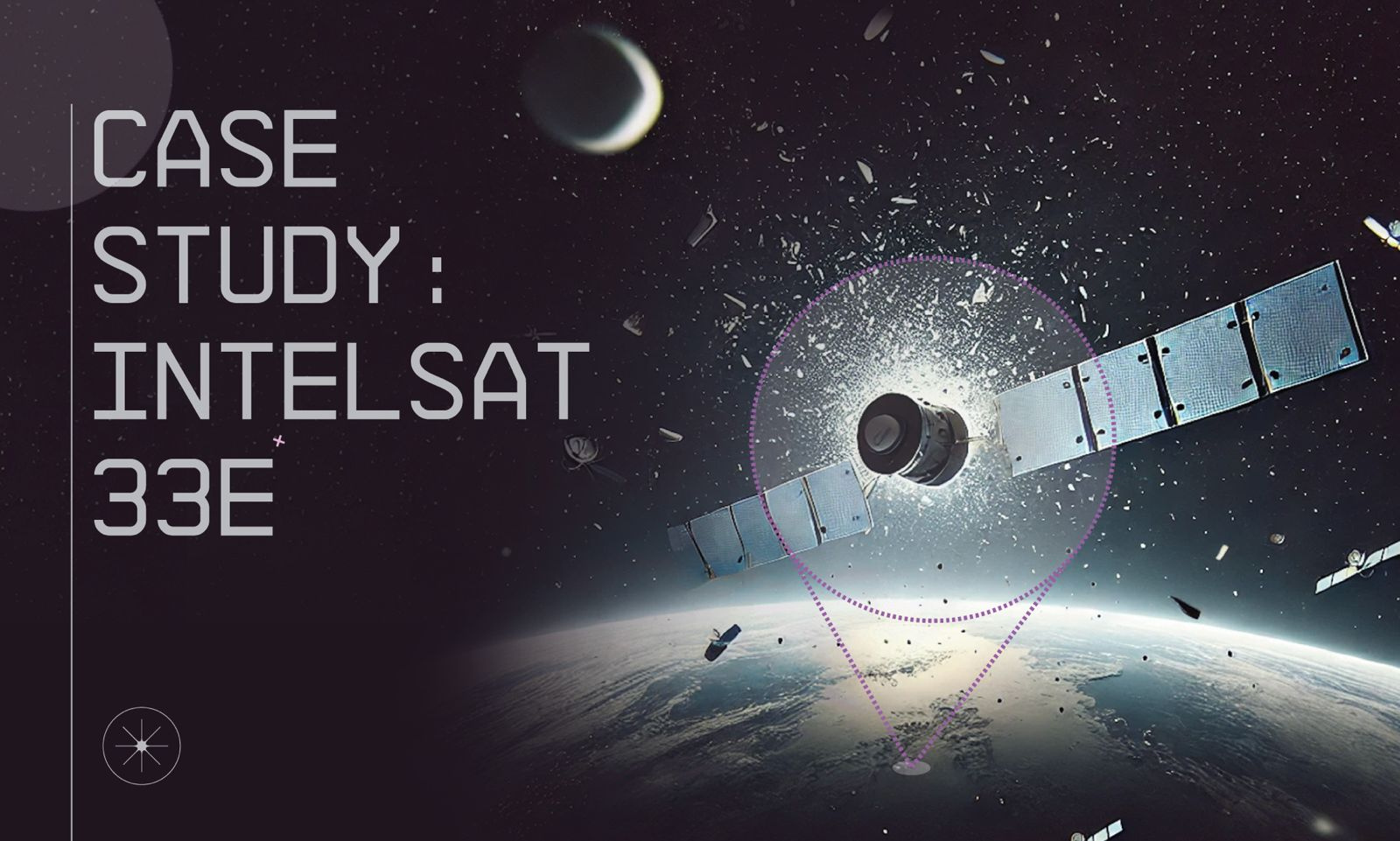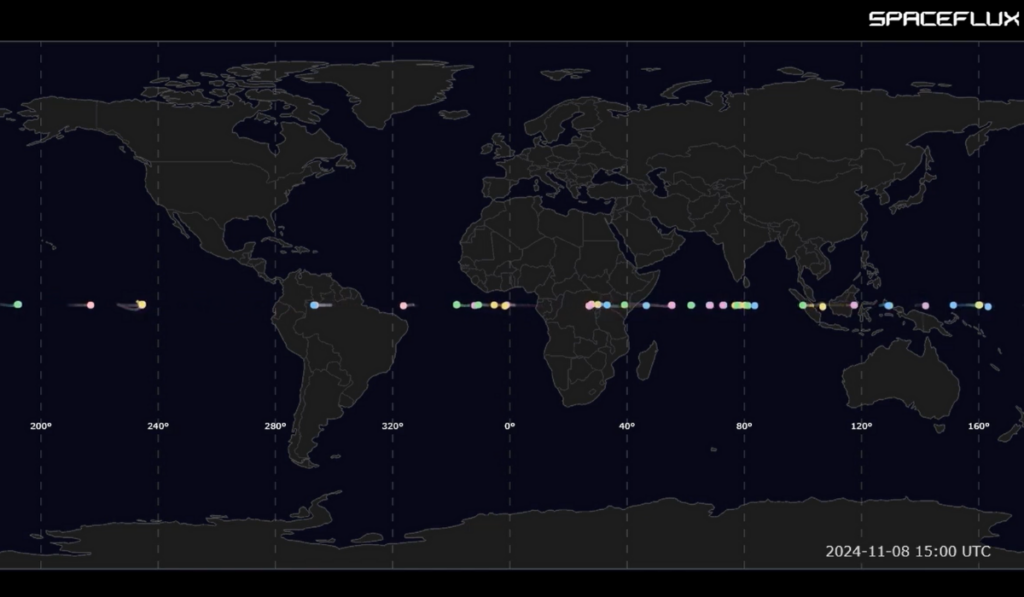Navigating the Fallout: A Case Study on Spaceflux’s Role in Tracking the Intelsat 33E Fragmentation

At 04:30 UTC on 19th October 2024, the geostationary communications satellite Intelsat 33E (IS-33e) experienced a catastrophic failure, resulting in its fragmentation in geostationary orbit (GEO). Spaceflux played a pivotal role in responding to this event as the first commercial entity to publicly announce the anomaly and providing critical tracking data to government and commercial clients. This post explores the event, Spaceflux’s response, and its significance for space operations.
The Intelsat 33E Fragmentation
IS-33e was stationed at 60 degrees East longitude, serving Europe, Africa, and the Asia-Pacific region. The satellite suffered a sudden power loss, leading to its fragmentation into dozens of pieces. Initial reports tracked around 20 fragments, though at the time monitoring of the event led us to believe the actual number was much higher.
Despite the increased spatial density at geostationary (GEO) altitude, this debris field poses significant risks to operational satellites in GEO, a vital orbital region for global communications and navigation. The incident underscores the growing challenges of space debris management in increasingly congested orbital environments.
Spaceflux’s Swift Response
Spaceflux acted immediately, leveraging its proprietary global optical sensor network and AI-powered CORTEX analytics platform to detect and monitor the fragmentation. Using our proprietary faint object stacking algorithms, we identified even the smallest fragments enabling us to deliver a large volume of precise positional data over a wide range of fragment types.
Our routine surveillance of the GEO belt enabled continuous and accurate tracking of the debris. This data was shared with multiple government organisations and commercial operators. Delivery to the UK government, including the UK Space Agency (UKSA) and the Ministry of Defence (MoD), supported their role in national security and the safeguarding of UK space-based assets. Spaceflux’s data informed decisions on collision avoidance and long-term risk management in this orbital regime.
Sustained Monitoring Efforts
Beyond the initial detection, Spaceflux continued tracking the resulting fragments for several weeks, enhancing our customer’s space situational awareness during the critical early stages of the event.
The high-energy breakup led to a rapid dispersal of fragments, with some delta-V values exceeding 500 m/s – an impressive fraction of GEO’s typical orbital velocity of 3 km/s. These significant velocity changes caused drastic shifts in fragment trajectories, pushing some into graveyard orbits posing a risk for centuries to come as further fragmentation events can push space debris back into active orbits.
During this sustained tracking period, we routinely detected fragments with visual magnitudes greater than 20.5. These hard-to-track faint fragments make up the majority of the fragment population.
Visualising the fragments that Spaceflux tracked in the weeks following highlights this rapid debris dispersal across the GEO belt as well as the ability of the Spaceflux optical sensor network in tracking debris across the globe, ensuring comprehensive situational awareness to safeguard the GEO environment.

Why This Event Matters
The IS-33e fragmentation highlights the dangers posed by space debris in GEO. Fragments in GEO can remain in orbit indefinitely. Even small pieces traveling at high velocities pose catastrophic risks to operational satellites.
While the vastness of GEO reduces short-term collision probabilities due to its lower spatial density and lower relative velocities compared to LEO, this event has been one of the most significant fragmentations in the orbit.
Conclusion
The Intelsat 33E fragmentation serves as a stark reminder of the threats posed by space debris and the importance of proactive monitoring. Spaceflux’s swift actions and sustained tracking efforts have supported the UK Government’s national security activities and underscores our role in safeguarding orbital environments. By providing accurate, timely data, we help protect vital space assets and ensure a sustainable future for global satellite operations.
PRESS RELEASE – Spaceflux awarded multimillion-pound UK Government contracts to deliver sovereign Space Surveillance and Tracking
London, UK 20/11/2025 – Spaceflux Ltd, a UK-based leader in space domain awareness (SDA) and space intelligence, has won all three major multimillion-pound, multiyear UK government contracts to provide advanced space surveillance and tracking (SST) data across multiple orbital regimes. The UK Space Agency (UKSA) and the UK Ministry of Defence (UK MoD) contracts, awarded under…
The Silent Sentinel: How Space Domain Awareness is Supporting Modern Conflicts
By Kerri Mertz As conflicts on Earth become increasingly reliant on assets in orbit, the importance of space as a contested military domain has never been clearer. The war in Ukraine has underscored a pivotal shift: space is no longer a backdrop to terrestrial operations—it is a frontline in its own right. At Spaceflux, we…
PRESS RELEASE – Spaceflux secures £5.4M to accelerate its growth as a key global player in Space Domain Awareness
Leading UK satellite tracking company raises £5.4 million in seed funding to expand its global telescope network and accelerate development of AI-powered space situational awareness solutions. The company will enhance its 24/7 monitoring capabilities to serve government and commercial customers addressing increasing challenges of orbital congestion and space security. London, 25th July 2025 – Spaceflux,…
Newsletter signup
Stay informed about the latest advancements in optical space tracking, technology releases from Spaceflux Labs, and early access to new capabilities.